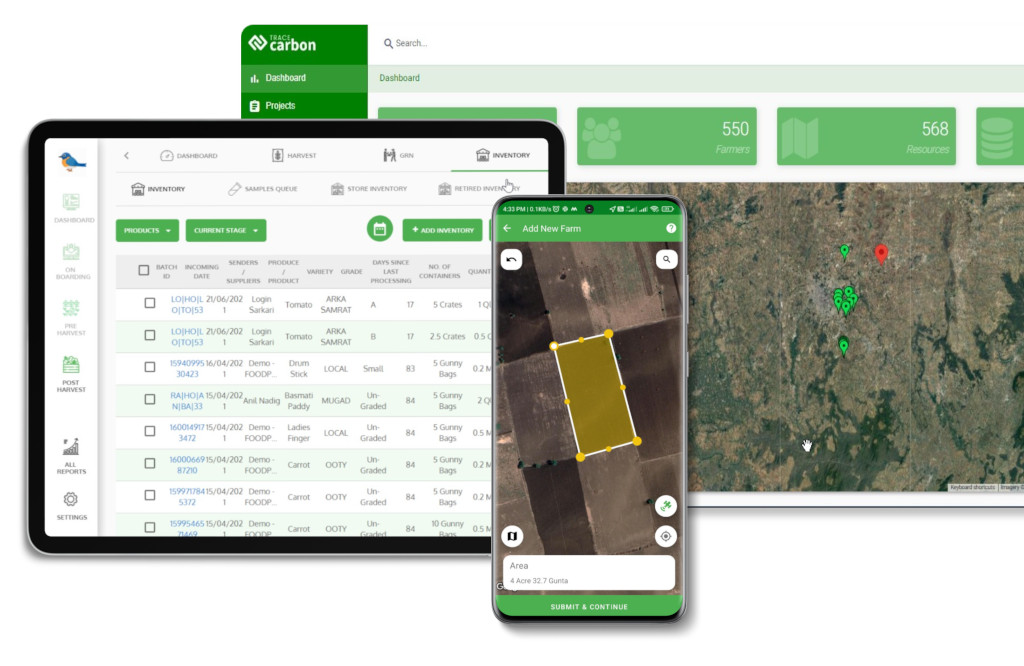Contact: +91 99725 24322 |
Menu
Menu
Quick summary: Ensure EUDR compliance with TraceX’s GeoJSON-powered platform. Capture, validate, and integrate GPS plot data seamlessly to avoid DDS rejections and meet EU traceability mandates.

The TraceX EUDR Platform enables precise GeoJSON data capture through GPS-based point and polygon mapping for farms. It includes built-in geometry validation tools to ensure compliance with EU spatial data requirements, reducing DDS rejection risk. The platform supports export-ready GeoJSON files and automates integration into Due Diligence Statements (DDS).
Under the EU Deforestation Regulation (EUDR), providing accurate geolocation data is non-negotiable. Without validated farm coordinates in GeoJSON format, Due Diligence Statements (DDS) may be rejected—blocking product entry into the EU. Most agri-exporters and operators struggle with capturing valid GPS data, especially when working with smallholders or fragmented supply chains. Errors in format, geometry, or location accuracy can result in costly compliance failures.
This guide explains why geolocation is foundational for EUDR compliance and how the TraceX platform automates point/polygon mapping, validates geometry in real time, and ensures data meets EU TRACES specifications—at scale and without manual bottlenecks.
Key Takeaways
Under the EU Deforestation Regulation (EUDR), accurate farm geolocation is non-negotiable—and GeoJSON is the gold standard format for spatial data. Exporters and importers must capture precise point or polygon coordinates, validate geometry, and ensure metadata aligns with TRACES protocols. Manual methods often lead to errors, data gaps, or rejected Due Diligence Statements (DDS).
TraceX’s EUDR Platform eliminates these bottlenecks by automating GeoJSON capture, validating coordinates at source, and generating DDS-ready outputs. Whether you’re managing 30 farms or 30,000, TraceX scales seamlessly across complex supply chains—enabling error-free, audit-ready compliance.
GeoJSON is a digital file format used to represent geographic features—like farm boundaries or field points—with associated location data in a structured, machine-readable format. It’s the official spatial data format accepted under the EU Deforestation Regulation (EUDR).
For farms under 0.5 hectares, EUDR allows single GPS point coordinates. For anything larger, polygon mapping (marking all boundary corners) is mandatory. This ensures precise traceability of the farm’s location and footprint.
GeoJSON files submitted to the EU TRACES portal must include spatial coordinates, geometry type (point or polygon), reference system (WGS84), and timestamps. Incomplete or improperly formatted files are a top reason for DDS rejection—making accurate GeoJSON generation essential for compliance.
To comply with the EU Deforestation Regulation (EUDR), operators and traders must provide precise farm-level geolocation data for all sourced commodities. This involves capturing either a GPS point for plots smaller than 0.5 hectares or a polygon boundary for larger plots.
Accepted spatial file formats include .geojson, .kml, and .csv, with GeoJSON preferred due to its compatibility with the EU TRACES system. Each file must include accurate metadata (coordinates, timestamps, boundaries) for submission.
Why it matters: Without validated geolocation data, Due Diligence Statements (DDS) can be rejected, leading to shipment delays or denial of market access. Geometry validation tools ensure spatial accuracy and reduce the risk of non-compliance under EUDR.
Learn what the EU really expects, how to avoid costly GeoJSON mapping errors, and ensure your farm plots don’t get flagged.
Read our blogs on
Many operators and exporters face challenges while collecting GeoJSON data for EUDR compliance. Common pitfalls include:
These errors can result in DDS rejections, regulatory delays, and possible shipment holds. Using a digital platform with built-in geometry validators, real-time GPS mapping, and offline capabilities ensures spatial accuracy and reduces compliance risk.
Discover how a leading tyre exporter achieved EUDR compliance across 30,000+ farm plots using TraceX’s GeoJSON mapping solution.
[Read the Full Case Study →] and learn how you can simplify geolocation, reduce compliance risks, and scale your sustainability efforts today.

TraceX’s mobile app—equipped with offline capabilities—allows field officers to digitally map farms using accurate GPS coordinates. Whether using point mapping for smaller plots or full polygon outlines for larger farms (as required under EUDR), the system ensures precise boundary capture at the source.
Built-In Geometry Validation Engine
Immediately after plot capture, TraceX’s platform runs automated geometry checks to flag:

TraceX auto-generates compliant .GeoJSON files for each validated plot, including all required metadata (plot ID, timestamp, farm ID, etc.). These files are directly exportable for EUDR DDS creation or pushed to the EU TRACES system via integration.
Each mapped plot is linked to the supplier profile (farmer, FPO, or aggregator) in the TraceX system. This unifies geolocation data with KYC, land documents, and sustainability certifications, enabling seamless due diligence workflows.
TraceX maintains version histories for each GeoJSON file and logs all changes. This provides a full audit trail for 5+ years, ensuring that every mapped farm can be reviewed, verified, and referenced during inspections or audits.
Using satellite imagery and integration with datasets like Hansen Global Forest Change or JRC Deforestation Layer, TraceX overlays plot boundaries against forested or protected zones—offering deforestation risk insights in real time.
A key challenge in EUDR compliance is ensuring that Due Diligence Statements (DDS) are complete, accurate, and properly formatted for EU TRACES. GeoJSON integration plays a crucial role by enabling:
This streamlines the end-to-end workflow—from farm mapping to DDS submission—and gives operators confidence that their documentation meets EU compliance standards.

A global tire exporter, sourcing natural rubber from multiple countries, faced the challenge of validating and submitting GeoJSON files for over 30,000 rubber farm plots across 70,000 hectares to meet EU Deforestation Regulation (EUDR) standards. These plots came from suppliers each with varied documentation and mapping quality.
Using the TraceX EUDR Platform, the company:
Outcome: The exporter successfully ensured traceability and legality across its entire rubber supply base, avoiding DDS rejection and enabling uninterrupted EU market access.
Navigating the geolocation demands of EUDR doesn’t have to be complex. With TraceX’s EUDR Platform, businesses can automate the capture, validation, and integration of GeoJSON data across thousands of farm plots. Whether it’s ensuring accurate spatial records, aligning with EU schema, or generating ready-to-submit DDS files—TraceX delivers a streamlined, audit-ready solution to keep your supply chain compliant and traceable.
Want to stay ahead of EU deforestation regulations? Discover how producers and exporters can ensure compliance, file accurate Due Diligence Statements, and minimize sourcing risks.
Risk Reduction in Deforestation-Free Supply Chains.
Yes, TraceX allows bundling multiple validated GeoJSONs per DDS, provided metadata and sourcing details are consistent and compliant.
TraceX’s platform flags errors in real-time and prevents submission until the geometry passes EU schema validation—saving time and avoiding DDS rejection.
Absolutely. The platform captures both point and polygon GPS data and auto-validates them based on the ≥0.5 ha threshold outlined in EUDR.
